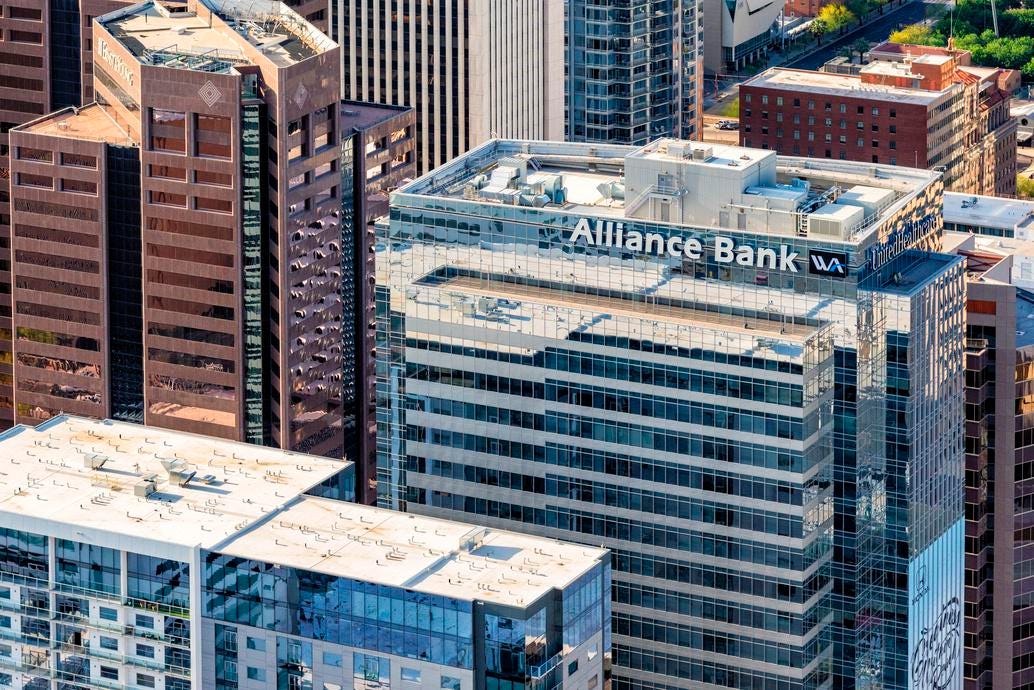Regional bank stocks spent last week trying and largely failing to recoup any losses from the contagion fears surrounding the failures of Silicon Valley Bank and Signature Bank, and the crisis appears to be far from over.
The SPDR S&P Regional Banking ETF (KRE) fell 6% Friday and is down 27% in the last month as investors worried about carrying too much risk into the weekend. The next domino fell on Sunday when UBS agreed to buy troubled Credit Suisse for about $3.25 billion in a fire sale, 60% lower than where its stock closed on Friday.
It would be easy for investors to steer clear of the riskiest corner of the current market, but heightened fear can create outsized opportunities, and billionaire Bill Ackman tweeted last week that regional banks are an “incredible bargain.” Analysts emphasize that investors need to be able to stomach some risk but still see signs of hope for some of these stocks.
“The market is in many ways doing a ‘shoot first, figure it out later’ mentality,” says Chris McGratty, head of U.S. bank research at KBW. “Most banks that we’ve talked to had some really unsettling deposit trends last Monday, but each day that’s gone by it’s gotten better.”
McGratty’s favorite stock among the hardest-hit names recently is Phoenix-based Western Alliance Bancorp. (WAL), a bank with $68 billion in assets and 36 locations concentrated in the western United States. Its stock is down 57% in the last two weeks, though it has recovered 25% since its low point last Monday. It’s currently trading below its tangible book value and has a more diversified customer base than SVB did, McGratty says. The bank issued a press release on Friday to reassure investors, saying it had more than $20 billion in immediately available liquidity, 55% of its deposits are insured and net deposit outflows had stabilized quickly.
McGratty also recommends Evansville, Indiana, based Old National Bancorp. (ONB), which has a more conservative risk profile, consistent earnings and a 3.7% dividend yield. Its decline in the last month is just 14%. He upgraded New York Community Bancorp. (NYCB) as well following Sunday’s news that it’s buying most of failed Signature Bank’s assets for $2.7 billion—the bank gained 35% Monday following the news, recouping all of its losses from the previous two weeks.
Analysts are more wary of First Republic Bank, the San Francisco-based bank that caters to a wealthy clientele and has suffered the most collateral damage from the SVB collapse. Its stock is down 84% in the last two weeks and fell 33% on Friday, a day after 11 banks including JPMorgan, Citigroup, Bank of America and Wells Fargo committed $30 billion in deposits to prompt a 70% intraday gain Thursday.
“The reason they’re taking $30 billion is because the deposit outflow situation had become pretty hard,” says McGratty. “The initial read was that it was a really great piece of information, but if you look through it a little bit more, the reason they’re doing this is not because of a position of strength.”
First Republic is in talks to sell a piece of itself, the New York Times reported Friday. Its high net worth customers would be an appealing feature for a competitor to acquire at the right price, but it has steered itself into trouble in part due to low fixed-rate mortgages it offered to these clients which have lost value in the last year of rising interest rates. Its credit rating was cut multiple times by S&P Global over the weekend into junk territory, and it’s down another 13% Monday morning.
“If you come to the conclusion that the bank will stay in business, then your decision concerning the stock is related to, ‘What is the earnings outlook?’ And the earnings outlook is very stressed,” says Dick Bove, a banking analyst at Odeon Capital Group. “In many cases they have fixed rates below the market because the rates were set to attract big depositors into the bank or big investors into their investment company, so the portfolio is not yielding a lot.”
Even before the chaos of the last two weeks, regional bank stocks have lagged the market for a long time. The KRE ETF is now down 23% in the last five years, compared with a 52% gain for the S&P 500 Index.
Bove thinks the acute fears of widespread failures for banks is “pretty much over,” creating an opportunity for a rebound, but he’d still rather be in bank preferred stocks than in common stock. Many preferreds are now offering a yield of 6% to 7%. Among 20 recommended preferred stocks, Bove highlights a 6.2% PNC issue now yielding 7%, a 5.6% Wells Fargo yielding 6.2%, a 5.3% preferred from U.S. Bancorp yielding 5.7% and a safe 4.55% JPMorgan preferred that currently offers 5.7%.
“These banks are definitely not going to miss the preferred payment, particularly if they have to sell common equity,” he says. “I don’t want to deal with all this crap about what they’re going to earn or the amount of money they have to raise. With the bank preferreds, I’m in my view totally protected, I get a high yield and I think that’s the way to go.”
Read the full article here










